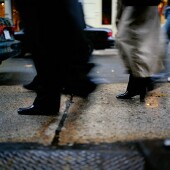 |
 |
 |
||
    |
||||
|
||||

Adapting Gait May Help Elderly Avoid Falls
Volunteers trained on moveable platform kept better balance in a slippery situation|
|
HealthDay
By Robert Preidt
Friday, February 20, 2009
 FRIDAY, Feb. 20 (HealthDay News) -- Repeatedly exposing people to situations where the footing is unstable helped train them to maintain their balance on slippery floors and avoid falls, says a University of Illinois at Chicago study.
FRIDAY, Feb. 20 (HealthDay News) -- Repeatedly exposing people to situations where the footing is unstable helped train them to maintain their balance on slippery floors and avoid falls, says a University of Illinois at Chicago study.
The research improves understanding of how the brain develops fall prevention strategies that can be used in a variety of situations. And experts say such training might prove particularly helpful for elderly people, who are at increased risk for falls that can lead to serious complications, disability and death.
The study included eight volunteers who trained on a moveable platform that could be operated to disrupt a person's balance and a group of seven who did no training on the platform. All participants were asked to walk on a vinyl surface that had one slippery spot that they couldn't see.
No one in the group that had been trained fell on the slippery floor, and seven of the eight never lost their balance. Those who hadn't been trained had more trouble coping with the slippery surface.
The trained volunteers were better at controlling the landing foot -- the foot that's on the ground when someone starts to slip. They could slow the movement of the landing foot as it began to slide forward, whereas the landing foot of the untrained participants went out from under them much faster, the study found.
"Controlling this foot, which is sliding forward, plays an important role in maintaining stability and prevents a backward fall," study co-author Yi-Chung Pai said in an American Physiological Society news release.
Pai and colleague Tanvi Bhatt also found that the trained participants unconsciously changed their gait when they began to slip. They used a flatter landing foot and bent the landing knee more, which helped reduce the velocity of the slip, the researchers said.
The study, which was published in the Journal of Neurophysiology, included young adult volunteers. Research is now being conducted with older adults.
HealthDay
Copyright (c) 2009 ScoutNews, LLC. All rights reserved.
Related News:
More News on this Date
Related MedlinePlus Pages:
| Home | Health Topics | Drugs & Supplements | Encyclopedia | Dictionary | News | Directories | Other Resources | |
| Disclaimers | Copyright | Privacy | Accessibility | Quality Guidelines U.S. National Library of Medicine, 8600 Rockville Pike, Bethesda, MD 20894 National Institutes of Health | Department of Health & Human Services |
Date last updated: 23 February 2009 |
